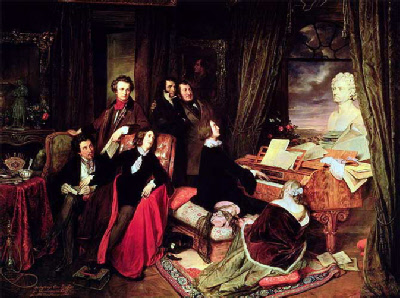1800-
Just as the word "Classical"conjures up certain images, Romantic is at
least as evocative. Whether we thinkof those romance novels with the
tawdry covers, or the paintings ofDelacroix, Romanticism implies fantasy,
spontaneity and sensuality.
The Classicalperiod focused on structuralclarity and emotional restraint.
Classical music was expressive, butnot so passionate that it could
overwhelm a work's equilibrium. Beethovenwho was in some ways
responsible for igniting the flameof romanticism, always struggled
(sometimes unsuccessfully) to maintainthat balance. Many composers of
the Romantic period followed Beethoven'smodel and found their own
balance between emotional intensityand Classicalform. Others reveled in
the new atmosphere of artistic freedomand created music whose
structurewas designed to support its emotional surges. Musical
story-
instrumentalmusic as well. The tone-
invention, as it was an orchestralwork whose structurewas entirely
dependent on the scene being depictedor the story being told.
Colorwas another important feature of Romantic music. New instruments
were added to the orchestraand composersexperimented with ways to
get new sounds from existing instruments.A large palette of musical
colorswas necessary to depict the exotic scenes that became so popular.
Exoticism was something of a 19thcentury obsession. Russian composers
wrote music depicting Spanish landscapes(Nicolai Rimsky-
Capriccio Espagnol, for example) andGerman composers wrote music
depicting Scottish landscapes (Mendelssohn'sScottish Symphony).
Operaswere set in exotic locales (Verdi's Aïda is set in Ancient Egypt).
In addition to seeking out the sightsand sounds of other places,
composersbegan exploring the music of their native countries.
Nationalism became a driving forcein the late Romantic period and
composers wanted their music to expresstheir cultural identity. This
desire was particularly intense inRussia and Eastern Europe, where
elementsof folk music were incorporated into symphonies, tone-
and other "Classical"forms.
The Romantic period was the heydayof the virtuoso. Exceptionally gifted
performers-
enormously popular. Liszt, the greatHungarian pianist/composer,
reportedly played with such passionand intensity that women in the
audience would faint. Since, likeLiszt, most composers were also
virtuoso performers, it was inevitablethat the music they wrote would be
extremely challenging to play.
The Romantic period witnessed an unprecedentedglorification of the
artist-
on our own culture.
